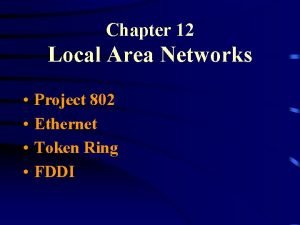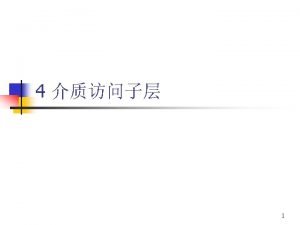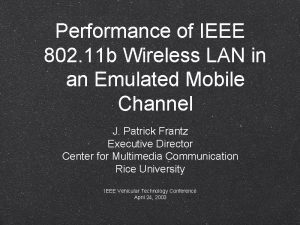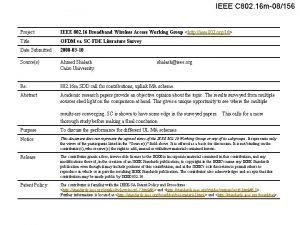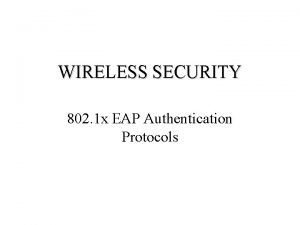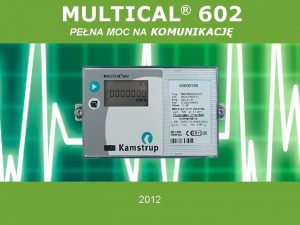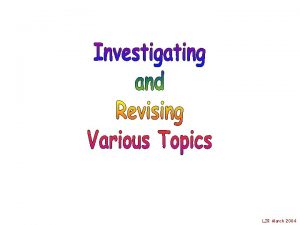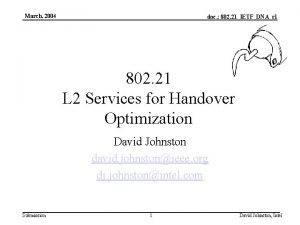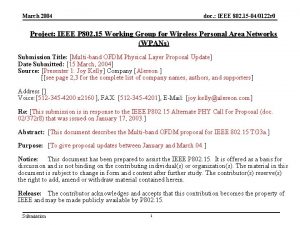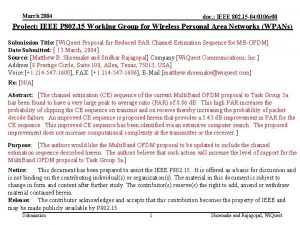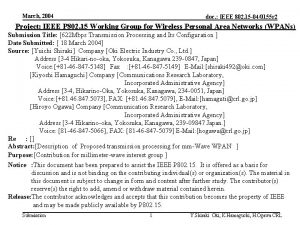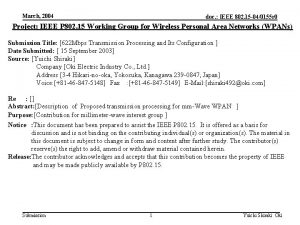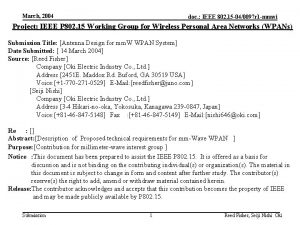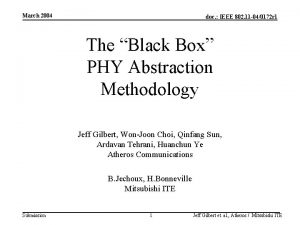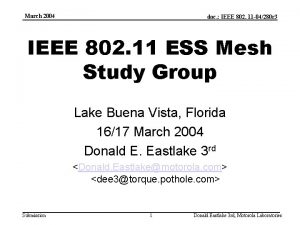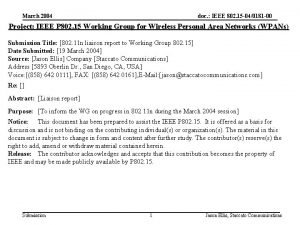March 2004 doc IEEE 802 11 04229 r

















- Slides: 17

March 2004 doc. : IEEE 802. 11 -04/229 r 0 Multiple Antenna OFDM solutions for enhanced PHY Presented by: Alexandre Ribeiro Dias Contributors: A. Ribeiro Dias, Stéphanie Rouquette-Léveil, Sébastien Simoens Motorola Labs Paris +33 (1) 69 35 48 32 alexandre. ribeirodias@motorola. com Submission 1 Alexandre Ribeiro Dias - Motorola Labs

March 2004 doc. : IEEE 802. 11 -04/229 r 0 Presentation Outline • • Introduction Multiple antenna techniques Multiple antenna PHY example Alternative OFDM modulators PHY simulation results MAC simulation results Possible MAC improvements Conclusion Submission 2 Alexandre Ribeiro Dias - Motorola Labs

March 2004 doc. : IEEE 802. 11 -04/229 r 0 Introduction (1/2) • PAR requirements: – Define modifications to both 802. 11 PHY and MAC so that a maximum throughput of at least 100 Mbps at the MAC SAP is enabled • Increase PHY performance (1/2): – If same bandwidth (proposed functional requirement) multiple antenna techniques are required to increase the peak data rate with good coverage (add advanced coding schemes? ) – Which multiple antennas techniques should be used? – How many antennas can be considered? Submission 3 Alexandre Ribeiro Dias - Motorola Labs

March 2004 doc. : IEEE 802. 11 -04/229 r 0 Introduction (2/2) • Increase PHY data rate (2/2): – How does « 100 Mbps at the MAC SAP » translates in terms of PHY data rate requirements ( depends on MAC efficiency depends on MAC amendment)? • Increase MAC SAP goodput: – How high can the throughput be with an enhanced PHY and 802. 11 or 802. 11 e MACs? – How much can this efficiency be increased with backward compatibility constraints ? Submission 4 Alexandre Ribeiro Dias - Motorola Labs

March 2004 doc. : IEEE 802. 11 -04/229 r 0 Multiple antenna techniques (1/5) • How can multiple antennas at the AP can be used to improve performance of legacy STAs? Partial channel state information, Closed-Loop (CL) technique UL Maximum Ratio Combining (MRC) Submission Transmit Selection (TS, per subcarrier, per antenna) 5 DL Alexandre Ribeiro Dias - Motorola Labs

March 2004 doc. : IEEE 802. 11 -04/229 r 0 Multiple antenna techniques (2/5) • Space Time Block Codes (STBC) to benefit from spatial diversity (with MRC) – Increase communication reliability/coverage – Not optimal for high data rates Submission 6 Alexandre Ribeiro Dias - Motorola Labs

March 2004 doc. : IEEE 802. 11 -04/229 r 0 Multiple antenna techniques (3/5) • Spatial Division Multiplexing (SDM): – Data rate multiplied by number of transmit antennas – Transmit diversity not exploited … … S/P ML, ZF, MMSE, SIC… based receivers • In general (depending on decoder) Nr Nt Submission 7 Alexandre Ribeiro Dias - Motorola Labs

March 2004 doc. : IEEE 802. 11 -04/229 r 0 Multiple antenna techniques (4/5) • Hybrid schemes: increase data rate and exploit transmit diversity for higher robustness/range • SDM combined with STBCs (Open Loop OL) • SDM combined with TS (Closed-Loop CL) N<Nt data streams S/P Submission S/P 8 Transmit Selection (TS, per subcarrier, per antenna) Alexandre Ribeiro Dias - Motorola Labs

March 2004 doc. : IEEE 802. 11 -04/229 r 0 Multiple antenna techniques (5/5) • Open-Loop vs Closed-Loop? • CL techniques known to provide substantial gain but how CSI can be obtained at the TX? – Reciprocity assumption in TDD systems? • Are RF impairments identical on UL and DL? • Delay between UL and DL needs to be controlled – Feedback link? • Needs to be implemented and additional overhead… Submission 9 Alexandre Ribeiro Dias - Motorola Labs

March 2004 doc. : IEEE 802. 11 -04/229 r 0 Multiple antenna PHY example • How many antennas should be used? – Antenna configuration should depend on STA size (laptop, mobile handset) – Ex: fixed number of antennas at the AP, several number of antennas (hence multiple antenna techniques) at the STA depending on dimensions/legacy AP 4 antennas, STA 1 antenna (legacy) Techniques MRC, TS? Modes Submission x. QAM+code rate? AP 4 antennas, STA 2 antennas (mobile handset) AP 4 antennas, STA 4 antennas (laptop) STBC, SDM, Hybrid? x. QAM+code rate? 10 Alexandre Ribeiro Dias - Motorola Labs

March 2004 doc. : IEEE 802. 11 -04/229 r 0 Alternative OFDM modulators • Cyclic Prefix OFDM (CP-OFDM) is an interesting option with simple equalisation scheme: • BUT: – Zero Padded OFDM (ZP-OFDM, CP replaced by zeros) solves the sensibility to channel zeros locations – Pseudo-Random Postfix OFDM (PRP-OFDM, CP replaced by pseudo-randomly weighted known postfix): • Keeps all advantages of ZP-OFDM • Low complexity channel estimation and tracking possible • Support for increased mobility (longer packets? ) • Alternative OFDM modulators worth being considered Submission 11 Alexandre Ribeiro Dias - Motorola Labs

March 2004 doc. : IEEE 802. 11 -04/229 r 0 PHY simulation results (1/3) • Simulation parameters: – – 256 QAM investigated to increase spectral efficiency NLOS TGn D channels (no spatial correlation) Packet size: 512 Bytes, 23 d. Bm transmit power ZF receivers when SDM-based techniques • All IEEE 802. 11 a functional blocks are kept: scrambler coder Legend: IEEE 802. 11 a block Submission interleaver mapping New block 12 Multiple Antenna System Processing OFDM modulation Alexandre Ribeiro Dias - Motorola Labs

March 2004 doc. : IEEE 802. 11 -04/229 r 0 PHY simulation results (2/3) • Use of STBCs for increased reliability: – Important range increase, even with legacy STAs Submission 13 Alexandre Ribeiro Dias - Motorola Labs

March 2004 doc. : IEEE 802. 11 -04/229 r 0 PHY simulation results (3/3) • Hybrid schemes for reliability and high data rate? – Hybrid schemes: range increase not very important, however reduces constraints on SNR requirements Submission 14 Alexandre Ribeiro Dias - Motorola Labs

March 2004 doc. : IEEE 802. 11 -04/229 r 0 MAC simulation results • Simulation Assumptions: –. 11 e MAC with Group Acknowledgement – 1500 byte payload – 16 MPDU per Group • Simulation Results: – Only 100 Mbit/s effective vs 162 Mbit/s theoretical with 3 streams and 64 QAM – MAC Efficiency is of only 54% for the 120 Mbit/s mode –. 11 e with Group Ack is too inefficient ! Submission 15 Alexandre Ribeiro Dias - Motorola Labs

March 2004 doc. : IEEE 802. 11 -04/229 r 0 Possible MAC improvements • Need to increase the PHY burst size by aggregating numerous packets (without SIFS between each packet) • Keep individual FCS per packet for SR-ARQ • Possibility to rely on the Contention Free Period of. 11 e to introduce more efficient TDD/TDMA MAC Submission 16 Alexandre Ribeiro Dias - Motorola Labs

March 2004 doc. : IEEE 802. 11 -04/229 r 0 Conclusion • . 11 e MAC not efficient with high data rate PHY • With enhanced MAC, PHY data rate of 162 Mbps might be sufficient (which is the best solution? ) • Antenna configurations should depend on STA size • Number or antennas/techniques used should be chosen to reduce constraints on SNR requirements and keep reasonable range Submission 17 Alexandre Ribeiro Dias - Motorola Labs












